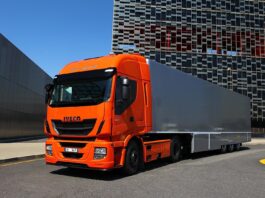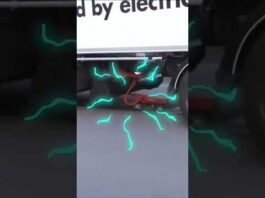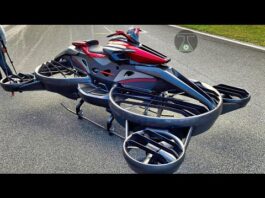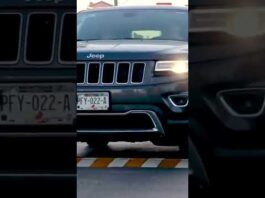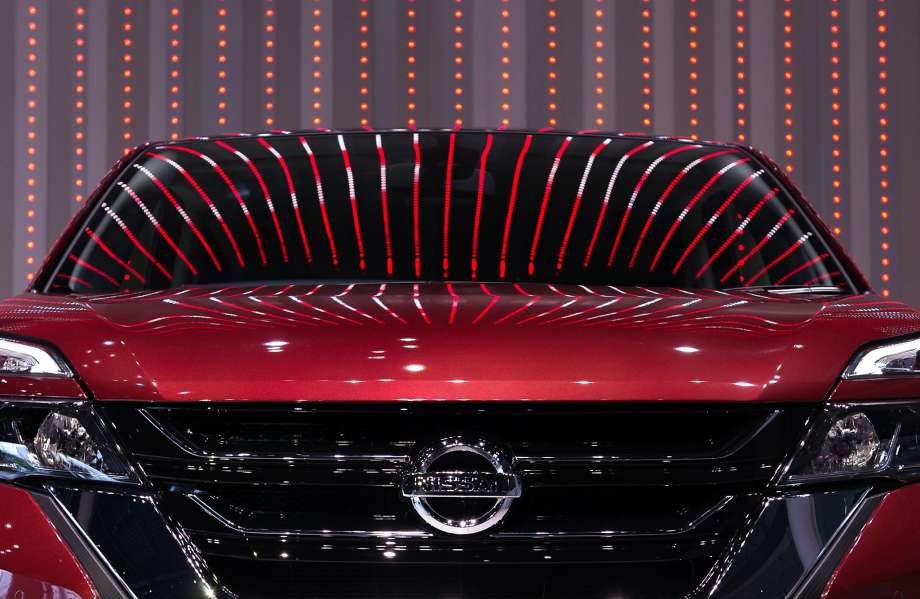
YOKOHAMA, Japan — As cars whizzed by on an expressway in an industrial area in Japan, the passengers inside a Nissan minivan placed their trust in its self-driving software.
Tracking nearby cars through a camera on the back of the rearview mirror, the Serena ProPilot positioned itself a safe distance from the sedan in front of it, maintained its speed, and slowed or stopped along with the rest of the traffic.
What’s different about this autonomous test drive is that it took place not in a prototype but in a model that began selling in Japan last year. It’s a huge bet not just for its manufacturer but for the island nation’s car industry. Nissan and other Japanese automakers have a goal to bring semiautonomous vehicles to city roads by 2020, the same year the Summer Olympics will take place in Tokyo.
If Japan’s auto industry misses that opportunity to show off its self-driving prowess, it could fall further behind. Once a colossus that threatened America’s image as the world’s primary industrial superpower, Japan now finds itself flat-footed in the race to develop driverless vehicles. As agile code development has supplanted lean manufacturing as the key ingredient for future cars, Silicon Valley holds a clear advantage.
The market for partially and fully autonomous vehicles is expected to grow to nearly $77 billion in 2035, representing a quarter of new cars sold, according to the Boston Consulting Group. Besides the consumer market, ride-hailing companies and delivery operations could be large buyers.
Nissan believes its ProPilot models represent early stage technology, not fully autonomous yet, that could lead to more advanced self-driving cars on the road. The company’s goal is to pioneer a system to produce autonomous vehicles in large numbers, enabling it to leapfrog over California rivals like Waymo, Uber and Tesla.

Nissan says more than half of the people who buy the Serena minivan are opting for the ProPilot system, which has limited self-driving capabilities.
The strategy, said Kazuhiro Doi, Nissan’s head of research, isn’t being first to market, but first to the mass market. He acknowledges that the ProPilot technology sold today is not that advanced. Other manufacturers have similar lane-keeping features, which are a step above cruise control. But Nissan has big ambitions to expand ProPilot into more car models and develop it for city driving and, one day, fully autonomous vehicles. And once it does, its factories can churn out self-driving cars faster than the upstarts.
Yet some analysts believe Japanese automakers are behind in the key area of computer vision technology, which is necessary for the city-mapping work that allows self-driving cars to safely navigate streets. Waymo, the Alphabet subsidiary that grew out of Google’s self-driving car project, is the widely recognized leader. It has logged more than 3 million miles since 2009. The company is bringing 600 minivans to the road and, in 2015, successfully transported a legally blind man who rode by himself in a self-driving car in Texas.
Gene Munster, a managing partner with Loup Ventures, a venture firm that tracks the autonomous driving industry, said he believes Japanese automakers and Detroit’s Big Three share similar problems. Their expertise is in building cars, not maps. Automakers must either enter into partnerships with mapping firms or quickly build the technology themselves.
“I think (Japanese automakers are) probably faring as good as Detroit (automakers are) faring — which is they’ve got a long way to go,” Munster said.
Despite all the buzz about self-driving cars, Japanese automakers seem to be left out of discussions. A recent analysis by tech news site the Information looked at 17 self-driving programs and ranked their progress. Japanese firms didn’t make the top five.
It’s a problem that goes beyond self-driving cars. Once a pioneer of technology, Japan churned out gadgets that caught on worldwide, like the Walkman and VCR. But sometime at the start of this century, Japan lost its edge. Apple unveiled the iPod, Google and Yahoo launched their popular search engines and the world turned its eyes to the Silicon Valley for innovation and never looked back.
A Serena minivan equipped with ProPilot mode is seen after a high way test drive at Nissan global headquarters in Yokohama, Japan.
A Serena minivan equipped with ProPilot mode is seen after a high way test drive at Nissan global headquarters in Yokohama, Japan.
Photo: Takashi Aoyama, Special To The Chronicle
The Switch of ProPilot mode is seen on the steering wheel of a Serena minivan at Nissan global headquarters in Yokohama, Japan.
The Switch of ProPilot mode is seen on the steering wheel of a Serena minivan at Nissan global headquarters in Yokohama, Japan.
Photo: Takashi Aoyama, Special To The Chronicle
A monitor of a Serena minivan equipped with ProPilot mode displays a lane-keeping feature during a highway test drive.
A monitor of a Serena minivan equipped with ProPilot mode displays a lane-keeping feature during a highway test drive.
Photo: Takashi Aoyama, Special To The Chronicle
Many of the people now pushing self-driving technology forward have no automotive background. Tesla’s Elon Musk, Uber co-founder Travis Kalanick, Alphabet’s Larry Page and Sergey Brin — who advocated the creation of what became Waymo — were all Internet entrepreneurs first.
“Elon Musk is the kind of entrepreneur we wish to have in Japan, but we know it’s going to be very much hard to have,” said Tomohiko Taniguchi, special adviser to Prime Minister Shinzo Abe’s Cabinet.
Taniguchi said many businesses, including those in Japan, have a “not invented here” mentality, meaning they prefer to build their own technology rather than use others. “You have to get rid of that culture and open up your field of research and development,” he said.
There are signs of change: Nissan and Honda have offices in the Bay Area, to tap into the region’s pool of talented software engineers. Last year, Toyota set up the Toyota Research Institute, with offices in Los Altos, Cambridge, Mass., and Ann Arbor, Mich., to focus on building software that it can use in all its vehicles. The institute, which has 170 employees, is focused on two areas: to build self-driving technology that will act like a guardian angel, taking control of a car when a driver is in danger; and software for fully autonomous cars that will chauffeur passengers.
The need for a shift has never been greater. Japan has a rapidly aging society with elderly residents stranded in far-flung towns with few options for travel except to get behind the wheel of a car. The Japanese census said 27 percent of the 2015 population was 65 years or older. Taniguchi said that at least once a month, he hears about car crashes involving senior drivers, many of whom confuse the gas pedal with brakes. He pointed to an accident in May where a woman in her 70s crashed through a hospital lobby, injuring 12 people.
“With the population aging that way, the need of introducing self-driving cars is paramount,” Taniguchi said. “You should waste no time.”
In June, the Japanese approved the creation of special zones in the country to test new technologies, including self-driving vehicles — something American self-driving entrepreneurs long for here. Taniguchi hopes that by next summer, there will be designated roads with speed limits of 25 to 31 mph, including ones in or near Tokyo and Nagoya, where self-driving cars can be tested.
For now, Nissan’s plans seem incremental: Last year, it released a ProPilot model of the Serena that can keep itself in a highway lane. It starts at $26,205. As of March, more than 50 percent of Nissan’s Serena C27 minivans had been sold with the ProPilot option, a sign of the popularity of its limited self-driving capabilities. A human driver must take over to change lanes.
As it makes ProPilot available in more vehicles, Nissan will add highway lane switching next year, and by 2020, it wants to make ProPilot capable of navigating city streets.
This step-by-step approach has skeptics. Research has shown that partial autonomy has its drawbacks. Human drivers rely too much on the car and aren’t able to direct their attention to the road fast enough when a partially autonomous system asks them to take over.
Munster, the venture capitalist, said an incremental strategy is a “losing approach” when you are way behind your rivals, as he thinks Nissan is. Once customers experience fully autonomous vehicles, they may never want to drive a car again, he said.
“Incrementalism doesn’t compete in a paradigm shift,” Munster said.
But John Paul MacDuffie, a professor of management at the University of Pennsylvania’s Wharton School, believes an approach like Nissan’s could be better at winning over customers. Studies have shown that customers who experience early forms of self-driving technology, like lane-keeping or self-parking features, are far more comfortable with the idea of driverless cars.
“First movers don’t always win technology wars,” MacDuffie said. “Fast followers are often in a better position, particularly given the costs involved. I can’t see it’s unwise for them to take this somewhat slower approach.”
Toyota has been researching autonomous technology since 2005 and holds the most patents in the area, said James Kuffner, the institute’s chief technology officer. Unlike a startup, Toyota has deep resources, and his team is excited that it could be building software for a “significant fraction of the vehicles that Toyota sells every year,” Kuffner said.
“The new oil in the field is really quantity and quality of data, and that is something that if you are larger and do have scale, it could potentially be an advantage,” Kuffner said.
But recruiting people in a tight-knit talent pool is not easy.
“First of all, new software people are not intent to come to carmakers first,” Nissan’s Doi said. “They are more willing to go into the new kind of startup or like a Google, Apple or those (other tech) companies.”
There are entrepreneurs in Japan, like Hirotaka Suzuki, who are intent on making their mark in self-driving cars. Suzuki is the chief technology officer of Tokyo’s SDtech, which is developing a user interface for autonomous vehicles. He prefers T-shirts, jeans and Crocs to traditional business attire. His technology will help self-driving vehicles explain themselves, through computerized speech, why they chose to slow down or shift lanes.
“Even if the vehicle is 100 percent for sure driving safe, without any interaction or communication, people will not trust the system,” Suzuki said.
Whether Japan has a shot at leading the world into autonomous cars is far from settled. Suzuki believes the government needs to allow companies to test new technologies in more public places at faster speeds. Otherwise, it will be difficult to obtain enough data to build better software, he said.
“We still need more freedom to try those things in the real street with real people,” he said.
SDtech has already entered into partnerships with some major Japanese automakers, but even Suzuki wonders whether one day he’ll open an office in Silicon Valley. He says there might be an entrepreneur like Musk, the Tesla CEO, in Japan one day. But most of the candidates end up moving to the U.S.
“Japan is not a good place for them to do business,” Suzuki said. “Sometimes it’s very difficult for us to finance the company in Japan because big companies hesitate to do anything new unless it’s 100 percent sure. Once you fail, that’s the end of the story.”
Wendy Lee is a San Francisco Chronicle staff writer. She recently traveled to Japan with the Jefferson Fellowship Program organized by the East-West Center, a nonprofit that tries to increase dialogue among the U.S., Pacific and Asian nations. Email: wlee@sfchronicle.com Twitter: @thewendylee


